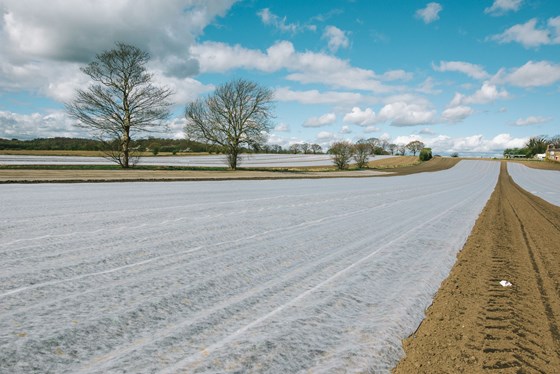News from the Field - May 2017
Spring has sprung on the Methley Estate, but the vegetables are keeping warm in their fleece!

As the ground dries, we’re starting to get onto the fields and on with planting this year’s spring crops. The malting barley has been drilled and we’ve also sown seven and a half acres of wild bird seed, and the same again of a pollen and nectar mix, in blocks across the estate to attract and provide food for wildlife.
Out and about you can’t miss the vividly yellow fields of oilseed rape, which provide a beautiful display at this time of year. However, the flowers are just the start of the story from our point of view. After the flowers, we await the seed pods, which initially contain green seeds. We then have to wait until these seeds turn black as this indicates the seed is mature and ready to harvest. During the next month or so we will have to ‘dessicate’ the plant, which involves taking away all the green material (stalk/leaves etc.), as this won’t go through the combine. We’ll look to harvest the crop during the second half of July and the oilseed we produce will be used in the manufacture of carrier bags. Apparently, it is used as a non-slip agent, presumably to try and counteract that awful battle of trying to open a carrier bag at the checkout!
You may also have noticed that the vegetables (cauliflower, broccoli and cabbage) in our fields are currently covered with a fleece-like material (pictured). This protects the crops from bird damage and keeps the plants warm, but if the weather stays as it is, these should be coming off very soon.
In the lowland areas of the farm, we are clearing out the ditches and drawing up new drainage plans, where required, to ensure our land drains are still adequate to take excess water away from the ground. In the Home Farm parkland, some of the drains are 40 years old – I know because I helped my father to dig them by hand at the time! Now, we approach the job in a much more sophisticated way, with mechanical digging equipment guided by GPS. Having done both, I definitely prefer the modern way!
Unfortunately, the modern way of poaching is not so fantastic, and as I’ve mentioned before, we are still getting 4x4 vehicles and quads crossing our fields in search of game. Whilst frustrating at the best of times, it really is annoying to see the damage being caused to our crops at this time of year as they start to grow taller.
One thing that I’m glad doesn’t change with time, is the traditional spring lambing season. We’ve had a great year with 25 of our Shropshire ewes producing happy healthy lambs, which can be seen skipping around the parkland. As a native breed they tend to produce just the one lamb, but we had a good few twins this year, which is really lovely to see. Spring is definitely one of my favourite times of the year!
Martin Hodgson, Farm Manager